M/E/A/N/I/N/G Online #1
Have Billboards Changed the Meaning
of Public Space in Poland?
"When Is a War Finally Going to Happen?" was the question posed to the Warsaw public on September 8th last fall on a billboard that showed a picture of a man lying down and gazing dreamily at the clouds. Three days later, the authors, artists from the art group Twozywo (Art Mater/i/n/al) covered the word "war" on this handmade billboard, changing its meaning in Polish into "When Is It Finally Going to Happen?" From the point of view of the management of Art Marketing Syndicate S.A. (AMS) this artwork, originally addressing the laziness and the thoughtlessness of the new consumerist society in Poland, had become, in the recent political context, "too prophetic." Indeed, it is not the first time that art on billboards sent a strong message to the public in Poland. The activities of the Galeria Zewnetrzna (Outdoor Gallery), an art project lead and sponsored by AMS, provide a good example of how the meaning of "public space" has changed in Poland during the last two decades.
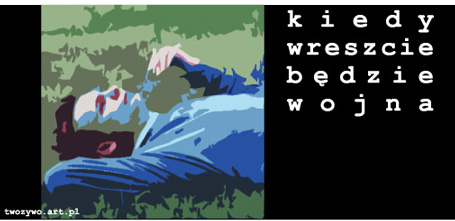 |
|
|
Under Communist rule the term "public space" did not exist. Being part of the official ideological realm, public buildings, company headquarters, streets, and squares remained a medium of the regime’s propaganda for over thirty years. Controlled by security officials and the Polish United Workers Party the outdoor premises, known currently as "public space," were not accessible for artists with the exception of those who served the official political system. Of course, the censors were sometimes not intelligent enough to do their job or had some sense of humor. It is hard to imagine that at a time when every image and word shown to the public required permission of censors the pathetic slogan, "Socialism is Our Target," was affixed for many months to the Hunters’ Union building in Warsaw, provoking much laughter among passersby. There is also a famous photograph of the Moskwa (Moscow) Movie Theater in Warsaw taken during martial law. It pictures a huge banner advertising Francis Ford Coppola’s movie Apocalypse Now! on the wall with police military forces marching in front of it outside the building. This image became one of the most memorable of those difficult times.
As a student of humanities during the martial law period, I observed for some time how a wall might become the object of an ideological battle. Taking a tram to the university campus, I would go through a narrow passage, facing one of the adjoining walls. "Down with Communism!" stated the graffiti one day. Overnight some policeman covered the sentence with fresh paint: "Down with Solidarity!" This dialogue continued with different contradictory sentences for the next few mornings. Finally the representative of one of the groups put on the wall: "Down with violation of the law!" This survived for quite a long time as it made everyone happy because the meaning of "violation of the law" was entirely different on both sides.
After the political transformation of 1989, when Poland officially became a parliamentary democracy again(1) the entire situation changed. Since the advent of outdoor market commodity advertisement, Poland has been shaken by several battles about freedom of market and its ethical approach. The content of an ad as well as the right to advertise certain products seems to create as hopeless a discursive impasse as pro-life, pro-choice, and other ideological dilemmas. It is mutually insoluble.
AMS started its Galeria Zewnetrzna project in 1998(2). The company sponsors art projects by leading and emerging Polish artists in regular campaigns that present an edition of 400 posters in major cities. Another project supports younger artists and groups to create a single piece on one temporarily donated billboard panel(3). An art historian, Lech Olszewski, is the company’s marketing director, and he runs the project with sociologist Marek Krajewski. They also support and collect some other phenomena of temporary interventions in public space, such as stencils and so-called "vlepki" (stickers illegally applied onto legally existing objects). Galeria Zewnetrzna’s program is innovative in a country with a strengthening advertisement market. It represents a buffer zone between the cynicism of contemporary commercial marketing and the ambitions of a Polish artworld that is having difficulties clearly communicating with its audiences(4). Using double-edged sword strategies to protect both the company income and its satisfaction with doing something creative, AMS has to make compromises in order to continue the project. In its promotional materials the gallery directors said: "The gallery is going to promote aesthetic alternatives to boredom and to the instrumental kitsch of the Polish contemporary city’s ionosphere.... In future editions of our venture we would like to present... antimoralistic and nonpropagandistic works, but at the same time involving both as content and form."
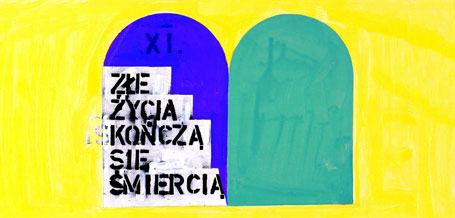 |
|
|
The AMS Outdoor Gallery got off to an ambitious start in its first year with a campaign entitled When Another Becomes the Other (this also could be translated as When the Stranger Becomes the Other). Pawel Susid’s Bad Lives End with Death, Anna Jaros’ We Are Horrible, or Jadwiga Sawicka’s Converting. Domesticating. Taming discussed some social issues, such as the acceptance of difference or the pressure of cultural paradigms.
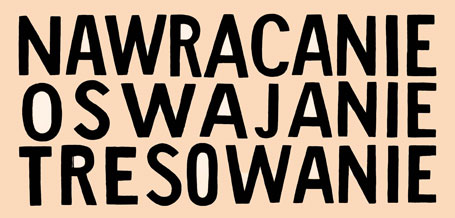 |
|
|
Enthusiastic press coverage helped to promote the project. But these first projects were not that disturbing as images, and their message was not very direct. Their meaning depended on the context of some other accompanying commercial ads. The situation changed in the summer of 1999.
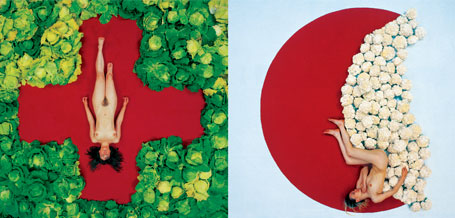 |
|
|
Katarzyna Kozyra, a younger artist and the winner of an honorable mention at the 48th Venice Biennale, was chased by the media and persecuted by right-wing politicians. She had become the informal winner of the national contest in controversy (if such a thing existed!). Thus no one was astonished when a billboard version of her Blood Ties produced in 1999 for the fifth edition of project caused greater turmoil compared to the previous ones. Blood Ties was made originally in 1995 as a four-piece photo work(5). Two of the photos show Kozyra nude and another two show her naked sister with a handicapped leg. Both young women lay down on a background of a red symbol--a cross or crescent--centered on white. Another element of the images are compositions of vegetables--cabbages or cauliflowers. All of the components are selected by usage of the principles of similarity versus difference. So siblings of similar age and appearance are differentiated by the use of images of disability and two great religious systems are depicted in conflict regardless of the common roots of their belief. And, of course, there is a reference to two famous charity organizations, which serve on war fronts around the world. For the billboard edition Kozyra selected two of the four images. She stated officially that she relates her work to the situation of victimized women during the war in the former Yugoslavia.
The work infuriated some right-wing politicians. One statesman from Gdansk even detected Satanism, since one of the young women is photographed upside down on the cross. Joanna Fabisiak from Solidarity Voting Action (AWS), who collected 800 Warsaw inhabitants’ signatures under a petition against the poster, explains: "This is not prudery or bigotry, but only a protest against liberalization of social norms." Undoubtedly, similarly to many other debates about the morality of art, this conflict is another ideological battle between liberalism and conservatism. Some members of the Polish Parliament accused the artist of offending the feelings of believers and tried to look for allies in some Islamic countries’ embassies in Warsaw but those diplomats declared politely that actually they enjoyed the pictures. Although those politicians did not succeed in creating an international scandal, the situation became too much for Polish authorities and the budget of Kozyra’s presentation in Poland National Pavilion at the Venice Biennale was radically cut. The posters were partly covered with paper, due to decision of the AMS management. Some cities asked the company to refrain from exhibiting the piece on their streets and their statement was accepted. The spokesman for the Polish Episcopate, Adam Schultz, stated that he can identify with the message of Blood Ties but he does not accept its form.
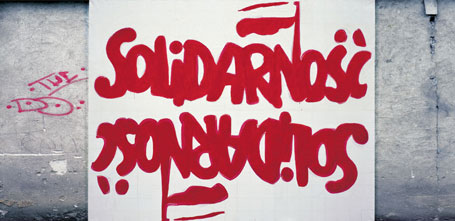 |
|
|
The fourteenth edition of the Outdoor Gallery Project in the summer of 2001 was a poster version of Marek Sobczyk’s What? Repetition (Solidarity). Just a few days before the 21st anniversary of the Solidarity movement, Sobczyk reminded the Polish nation of one of the most important cultural icons of the 80s, the famous red logotype of Solidarity that became an international trademark of resistance and victory of freedom. Sobczyk repeated the symbol upside down in a mirrored reflection. As the curators of Galeria Zewnetrzna noted the artist asks about the actuality of the value system that Polish society used to associate with this mark. Sobczyk’s project coincides with and emerges from the political situation of an electoral campaign, when the government established by Solidarity officials lost the trust and backing of the voters.
In 2000, the artists from the collective project named the Technical Culture Central Office (CUKT) had run a fake election campaign, scheduled for the entire year of the real presidential election in Poland.
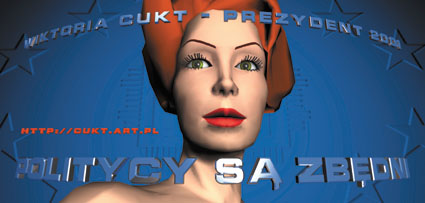 |
|
|
The artists created a candidate for the President of the Republic of Poland, who was not only a young attractive woman, but also a fully virtual, computer-generated being. The campaign of this long-legged beauty started on the internet. The idea was to promote the internet as the tool and institution of a democratic society. But, of course, the artists played with the illusion of democracy. The candidate was perfect for everyone, as she shared every opinion sent to her by e-mail. Her statements were completely contradictory, so as to please every possible voter. This internet project was followed by several election meetings and finally a billboard campaign with AMS, released exactly at the moment when "real" candidates started to present their own ones. This campaign really appealed to the Polish sense of humor, especially when the billboard of Victoria CUKT was shown, for instance, next to the billboard of President Krzaklewski from the Solidarity Union. Mr. President, whose campaign was based apparently on his attractive look(6), had no chance against red-haired Victoria. Regardless, she lost, but so did he(7).
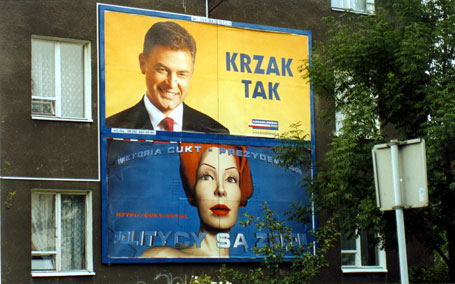 |
|
|
While some of the Galeria Zewnetrzna’s critics complain about most of the art billboards, indicating their lack of communication and clarity, more direct and provocative projects are criticized just because they are clear and communicative. AMS seems to be in a radically blocked situation, because most of the criticism comes from local politicians, and the economic situation of the company depends on good relationships with local governments. Online magazine Media i Marketing Polska noticed over two years ago that the situation may affect the AMS’s development and warned that the company may earn, since provoking Behaviors hard to accept(8), a reputation as a controversial company.
During the last ten years we have observed an increasing number of billboards in the countryside, caused by the lack of legal regulations, especially in the earlier period of establishing outdoor advertisement companies. Seen practically everywhere, in the most unexpected places, the billboard advertisements violently assault the eyes of the viewer and became one of the most successful mass-communication media. The only significant difference between art on billboards and art presented indoors is that it is shown to everyone unintentionally passing by. AMS Outdoor Gallery has the biggest audience among all of Polish art projects. It is also, more than any other art project, influenced by undercurrents of public opinion. As opposed to museums, it is not taking the risk of a cut-off of public funding but, rather, the loss of market income. Theoretically there is more freedom for a private, self-financed project, but when it takes place in a public domain, the situation is especially complicated. Considering these limitations, Galeria Zewnetrzna had to apologize several times for misunderstandings, miscommunications, and wrongly interpreted intentions. As Marek Krajewski stressed in his press release, the idea of his outdoor gallery comes from the lack of educated gallery-goers and a lack of professional art criticism in Poland. By dragging contemporary art into the public space Galeria Zewnetrzna influences the reception of art, which becomes a part of the public discourse.
Regardless of most of the debate’s rhetoric, no less populist than most of the political battles in the country in general, the discussion these art billboards provoked made citizens more aware of their rights and of the collective ownership of public spaces and the importance of visual culture. Despite the troubles involved with exhibiting contemporary art in public institutions, art on billboards has become an important element in the negotiation of a structure for the transformation of society. Is it a step on the path to understanding public art? Or is the negation and lack of understanding necessary for public art to exist?
(1) Poland is the oldest democracy
in Europe; the constitution of 3rd May is dated 1791 .
(2) The Outdoor Gallery also publishes free postcards
and maintains its own WebPages. Some other artists who took part
in their activities are: Jadwiga Sawicka, Pawel Susid, Monika Zielinska,
Rafal Bujnowski nad Sanislaw Drozdz. For more information search
www.ams.com.pl ;
(3) ICf. Galeria Otwarta in Krakow, its archive
and the locations map at www.galeria24h.virtual.pl .
(4) More about reception of contemporary art issues
in Poland in: Aneta Szylak, “New Art for New Reality. Some
remarks on Contemporary Art. in Poland,” Art Journal,
Spring 2000.
(5) One poster of the billboard edition was presented
in NYC at Exit Art in Fall 2000 in the exhibition The Body of
the East curated by Zdenka Badovinac from Lubljana.
(6) And a slogan “Krzak Tak” what means
“Krzak (his nickname) yes”, qualified by some political
marketing advisors as “the silliest election motto ever”;
(7) For more information search http://www.cukt.art.pl
;
(8) JP, Manipulacja przeslaniem, Media i Marketing
Polska, 3.06.1999.
Aneta Szylak has worked as a curator and art critic based in Gdansk, Poland since 1985. She is a Vice-President of the Wyspa Progress Foundation, a non-profit art organization established in 1994. In 1988, Szylak founded the Center for Contemporary Art Laznia (Bathhouse) and was its Director until Spring of 2001. Laznia is the only public art institution that emerged during the sociopolitical transformation and is now one of the major art spaces in Poland. She is a board member of Mare Articum Magazine in Poland and Polish Contributing Editor of the Central European Art Magazine Praesens and also edited the 1995 book The Site of Idea. The Idea of Site, covering the first 10 years of the Gdansk alternative art scene. She also writes for Art Journal.
| Contents: |
Hi, My Name is Artwork |
Is Resistance Futile? |
Is Resistance Futile? |
Is Resistance Futile? |
The White List |
Have Billboards Changed the Meaning of Public Space in Poland? |